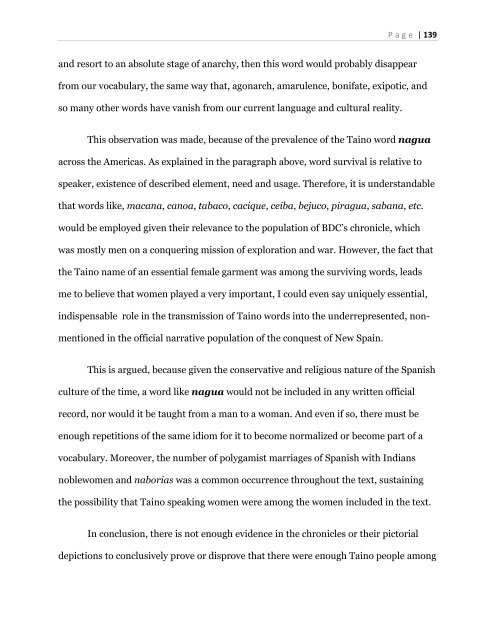Language of the Voiceless: Traces of Taino Language, Food, and Culture in the Americas From 1492 to the Present
by Leonardo Nin
by Leonardo Nin
You also want an ePaper? Increase the reach of your titles
YUMPU automatically turns print PDFs into web optimized ePapers that Google loves.
P a g e | 139<br />
<strong>and</strong> resort <strong>to</strong> an absolute stage <strong>of</strong> anarchy, <strong>the</strong>n this word would probably disappear<br />
from our vocabulary, <strong>the</strong> same way that, agonarch, amarulence, bonifate, exipotic, <strong>and</strong><br />
so many o<strong>the</strong>r words have vanish from our current language <strong>and</strong> cultural reality.<br />
This observation was made, because <strong>of</strong> <strong>the</strong> prevalence <strong>of</strong> <strong>the</strong> <strong>Ta<strong>in</strong>o</strong> word nagua<br />
across <strong>the</strong> <strong>Americas</strong>. As expla<strong>in</strong>ed <strong>in</strong> <strong>the</strong> paragraph above, word survival is relative <strong>to</strong><br />
speaker, existence <strong>of</strong> described element, need <strong>and</strong> usage. Therefore, it is underst<strong>and</strong>able<br />
that words like, macana, canoa, tabaco, cacique, ceiba, bejuco, piragua, sabana, etc.<br />
would be employed given <strong>the</strong>ir relevance <strong>to</strong> <strong>the</strong> population <strong>of</strong> BDC’s chronicle, which<br />
was mostly men on a conquer<strong>in</strong>g mission <strong>of</strong> exploration <strong>and</strong> war. However, <strong>the</strong> fact that<br />
<strong>the</strong> <strong>Ta<strong>in</strong>o</strong> name <strong>of</strong> an essential female garment was among <strong>the</strong> surviv<strong>in</strong>g words, leads<br />
me <strong>to</strong> believe that women played a very important, I could even say uniquely essential,<br />
<strong>in</strong>dispensable role <strong>in</strong> <strong>the</strong> transmission <strong>of</strong> <strong>Ta<strong>in</strong>o</strong> words <strong>in</strong><strong>to</strong> <strong>the</strong> underrepresented, nonmentioned<br />
<strong>in</strong> <strong>the</strong> <strong>of</strong>ficial narrative population <strong>of</strong> <strong>the</strong> conquest <strong>of</strong> New Spa<strong>in</strong>.<br />
This is argued, because given <strong>the</strong> conservative <strong>and</strong> religious nature <strong>of</strong> <strong>the</strong> Spanish<br />
culture <strong>of</strong> <strong>the</strong> time, a word like nagua would not be <strong>in</strong>cluded <strong>in</strong> any written <strong>of</strong>ficial<br />
record, nor would it be taught from a man <strong>to</strong> a woman. And even if so, <strong>the</strong>re must be<br />
enough repetitions <strong>of</strong> <strong>the</strong> same idiom for it <strong>to</strong> become normalized or become part <strong>of</strong> a<br />
vocabulary. Moreover, <strong>the</strong> number <strong>of</strong> polygamist marriages <strong>of</strong> Spanish with Indians<br />
noblewomen <strong>and</strong> naborias was a common occurrence throughout <strong>the</strong> text, susta<strong>in</strong><strong>in</strong>g<br />
<strong>the</strong> possibility that <strong>Ta<strong>in</strong>o</strong> speak<strong>in</strong>g women were among <strong>the</strong> women <strong>in</strong>cluded <strong>in</strong> <strong>the</strong> text.<br />
In conclusion, <strong>the</strong>re is not enough evidence <strong>in</strong> <strong>the</strong> chronicles or <strong>the</strong>ir pic<strong>to</strong>rial<br />
depictions <strong>to</strong> conclusively prove or disprove that <strong>the</strong>re were enough <strong>Ta<strong>in</strong>o</strong> people among


















